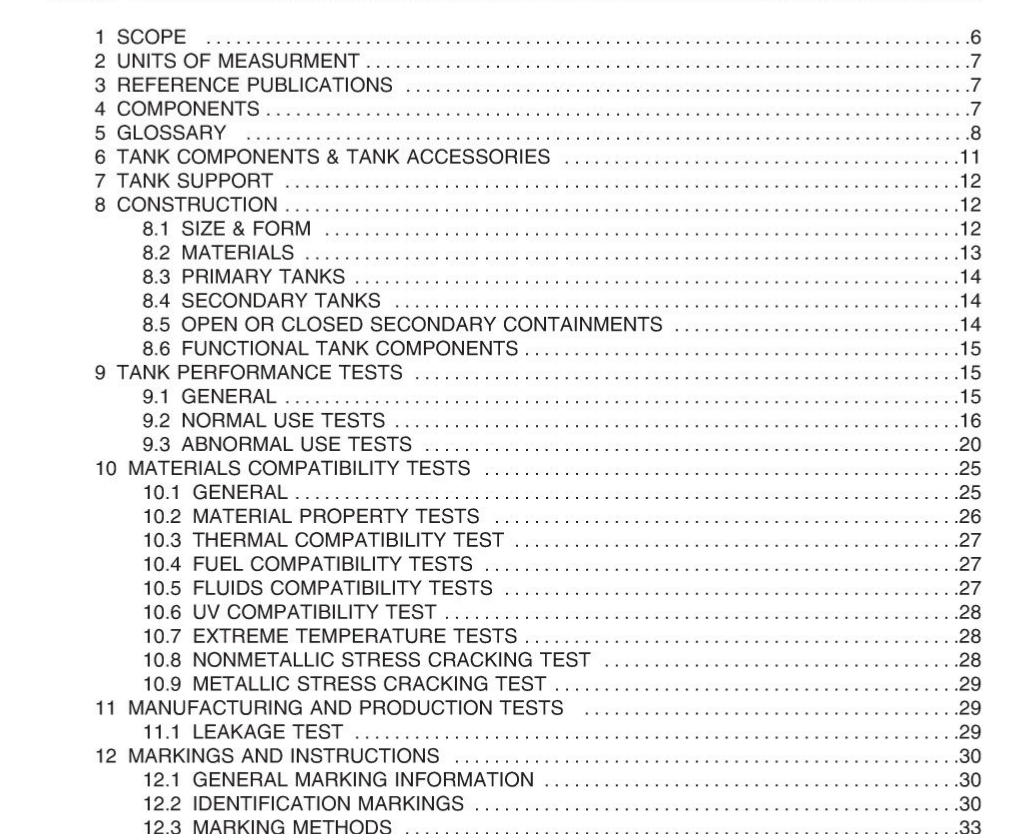UL 2258:2018 free download STANDARD FOR SAFETY ANSI/CAN/UL/ULC 2258:2018,Standard for Aboveground Nonmetallic Tanks for Fuel Oil and Other Combustible Liquids
1 sCOPE
1.1 This Standard covers the minimum requirements for nonmetallic or composite primary tanks,secondary tanks,and open or closed secondary containments from 227 to 2500 L (60 to 66o US gal)primary tank capacity intended primarily for the storage and supply of heating fuel for oil burningequipment, or alternately for the storage of diesel fuels for compression ignition engines and motor oils(new and used) for automotive service stations, in aboveground applications.
1.2 Each tank type is permitted to be fabricated in a combination of various shapes (cylindrical,rectangular or obround), orientations (horizontal, vertical) and may have integral options (tank supports oraccessories) as covered in this Standard.
1.3 These shop built tanks are completely fabricated, inspected, and tested for leakage before shipmentfrom the factory as completely assembled vessels except for options intended for field assembly inaccordance with the manufacturer’s instructions.
1.4 These tanks are intended for stationary installation and use in accordance with, but not limited to, anyof the following documents as appropriate for each country below.These tanks are not intended for thetransportation of fuel, nor are they intended to be transported while containing liquids.
A For the United States;ANSINFPA 31,Standard for the Installation of Oil-Burning Equipment;ANSI/NFPA 30,Flammable and Combustible Liquids Code; NFPA 30A,Code for Fuel
Dispensing Facilities and Repair Garages;
and the International Fire Code published by thelnternational Code Council.
BFor Canada; the National Fire Code of Canada; CSA B139,Installation Code for Oil BurningEquipment;
Regulations of the appropriate authority having jurisdiction; and CCME
Environmental Code of Practice for Aboveground and Underground Storage Tank SystemContaining Petroleum and Allied Petroleum Products.
1.5 These requirements do not apply to steel tanks covered by the following standards:
A UL 80,Standard for Steel Tanks for Oil-Burner Fuels;
B CAN/ULC-S602, Standard for Aboveground Steel Tanks for Fuel Oil and Lubricating Oil; UL142,Standard for Steel Aboveground Tanks for Flammable and Combustible Liquids;D CAN/ULC-S601,Standard for Shop Fabricated Steel Aboveground Tanks for Flammable andCombustible Liquids;
E UL 58,Standard for Steel Underground Tanks for Flammable and Combustible Liquids; or
F CAN/ULC-S603, Standard for Steel Underground Tanks for Flammable and CombustibleLiquids.
1.6 These requirements do not apply to nonmetallic tanks covered by the following standards:
A UL 1316, Standard for Glass-Fiber-Reinforced Plastic Underground Storage Tanks for Petroleum Products,Alcohols, and Alcohol-Gasoline Mixtures, and CAN/ULC S615, Standardfor Fibre Reinforced Plastic Underground Tanks for Flammable and Combustible Liquid; or
B UL 1746,Standard for External Corrosion Protection Systems for Steel Underground StorageTanks, and CAN/ULC-S603.1, Standard for External Corrosion Protection Systems for SteelUnderground Tanks for Flammable and Combustible Liquids.
1.7 These requirements do not cover storage of waste oils or other combustible liquids with different fire,physical or material compatibility properties with respect to the intended liquids in Clause 1.1 but do cover100 % biodiesel and biodiesel blends up to 100 %.These requirements do not cover storage of flammableliquids.
1.8 These requirements do not cover special evaluations for resistance to hurricanes,tornadoes,earthquakes, floods, fires or other natural disasters; or resistance to vehicle impact.
2 UNITS OF MEASURMENT
2.1 Values stated without parentheses are the requirement.Values in parentheses are explanatory orapproximate information.
3 REFERENCE PUBLICATIONS
3.1 Refer to Appendix B for a list of publications referenced in this Standard.Any undated reference toa code or standard appearing in the requirements of this Standard shall be interpreted as referring to thelatest edition of that code or standard. When the latest edition of a Standard is not applicable,theappropriate edition is indicated accordingly in Appendix B.
UL 2258:2018 free download
